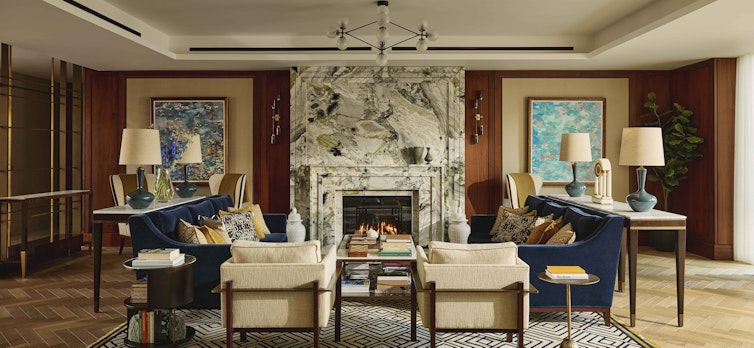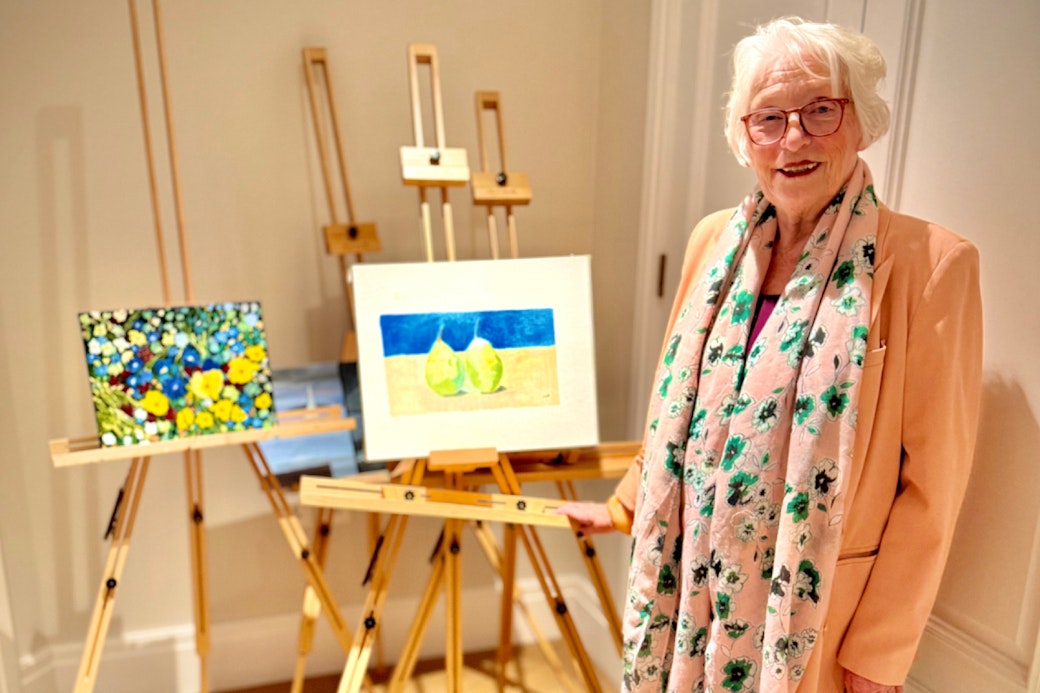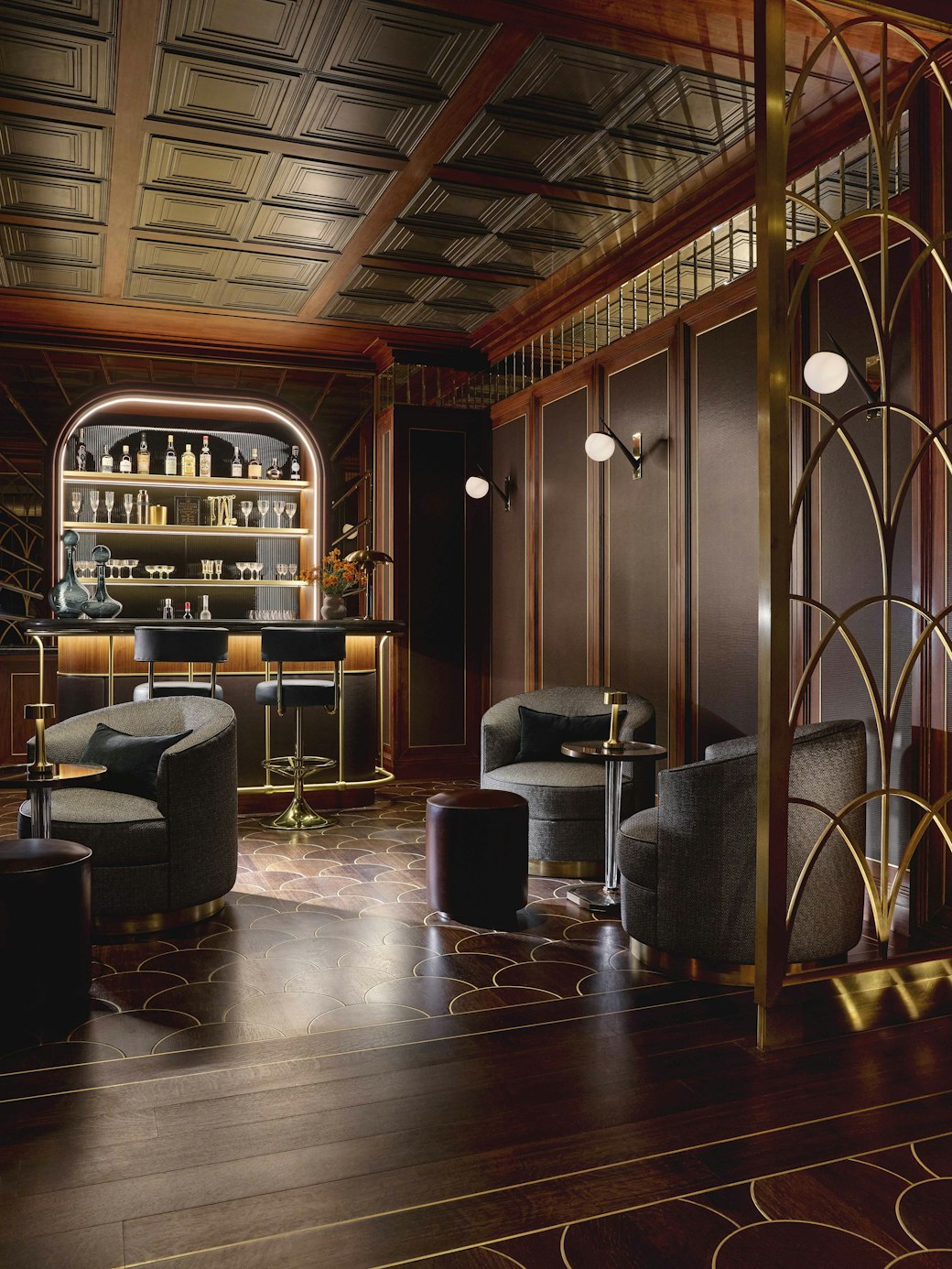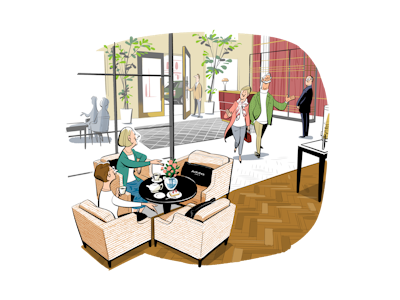It takes a village: Do we need to rethink our attitude to old age?

I enter a grand lobby, all lofty ceilings, marquetry floors and art deco fittings. An effusive concierge in a natty blue suit takes my bags, hands me a keycard to my suite and directs me to a bank of sofas, where I’m furnished with a crisp glass of viognier. I catch the eye of Paulene, who tells me she’s been on the cover of Vogue. Soon we’re sashaying arm in arm down a flight of marble stairs, exchanging stories about how we ended up here. We settle into a row of seats in the library for the evening’s entertainment: a spirited lecture on the sinking of the Titanic, delivered by a relative of someone who sailed aboard the ill-fated vessel.
Were you to stumble upon this place – and were you to make it into the secure building – you would be forgiven for thinking it was a new five star bolthole for the international jetset. But this isn’t a hotel and, at a mere 42 years old, I’m the youngest person in the room by several decades. This is Auriens, a Chelsea-based “later living” community where the minimum age is 65 and the average is north of 80. It’s a retirement community rather than a care home – you must be relatively healthy and mobile to move in and there are no doctors on site, although nurses and carers can be organised for an additional fee.
Residents are offered everything from state of the art medical check-ups and custom meal plans to a 24 hour concierge and a calendar packed with social events, all in a bid to keep them happy and healthy long into old age. I’m the first journalist to check in for an overnight stay to find out how the super-rich are seeing out their dotage and ask what – if any – lessons we can take into wider society.
Auriens, which opened in 2020 (sadly just in time for the pandemic), is unabashedly aimed at the top one per cent of the top one per cent. It offers both purchase and rental options, with prices to buy ranging from £2.75m for a one-bedroom apartment to £9.5m for the sprawling 2,500 square foot penthouse with views across Chelsea. Rent starts from just over £20,000 a month. And that’s before you add tailored support plans, meals at the restaurant, exercise classes, service charges… The list goes on.
In what seems like a baffling statistic, I’m told 80 per cent of residents here have flown on Concorde. One designed the Pimms bottle. Many were titans of industry or patrons of the arts (73 per cent are women, who live longer and are more likely to lose a partner). It is what you might call an elite crowd.
As you would expect, no expense is spared: there’s a speakeasy-style bar; a blue velvet residents’ cinema; a garden – rather cold and wet during my visit – designed by a gold medal-winning Chelsea Flower Show landscape architect, where live music events are held. There is a spa and a pool and a salon and a cutting-edge medical facility. It is nicer than just about any hotel I’ve stayed in.
Like the Titanic heading inexorably towards the iceberg, the UK is on a collision course with an old age crisis. In 2022, there were 12.7m people aged over 65, or just under a fifth of the population. According to the ONS this is set to rise to 22.1m, or 27 per cent of the population, by 2072. Almost a quarter of over-65s are expected to be in poverty by 2040.
Combine this with both a housing shortage and a welfare deficit and you have a major problem on your hands. How will we care for them all? How will we pay their pensions and their medical costs? Where will they live once they can no longer stay at home? And by “they” what I really mean is me.
Another issue is loneliness. In 2023, The World Health Organization declared loneliness a global health threat. The US surgeon general says its effects are equivalent to smoking 15 cigarettes a day, with the lonely seeing their chances of developing dementia increase by 50 per cent and the risk of heart attack or stroke increasing by almost a third.
“Everywhere you look, there are the wrong type of properties being occupied by the wrong people,” Auriens chief commercial officer Henry Lumby tells me. Clad in a pinstripe suit and pale pink tie, Lumby is a well-put together man in his mid-forties who looks every inch the luxury hotel manager; you can picture him scurrying along the corridors of the White Lotus putting out fires and dealing with stroppy guests. He’s worked in later living (“we hate the word ‘retirement’ here,” he hisses) for more than 20 years, describing it as both his profession and his passion.
“We need to see [residences like Auriens] across the country, across all price points and geographical regions,” he says. But while Australia and the US have around five per cent of the population living in such communities (Auriens is backed by a US private equity group), in the UK it’s just half a per cent. By Lumby’s estimations, we’re about 20 years behind.
The benefits of these communities, he says, wouldn’t just be felt by individuals but by the whole country. It adds to the stock of family housing and can help free up hospital beds. “Bed-blocking costs the NHS hundreds of millions a year,” he says with a sigh. “People go into hospital, perhaps after a fall, and their home is no longer fit for purpose but there’s nowhere to discharge them.” Several of the residents I talk to say that before moving to Auriens they hadn’t seen the upper floors of their homes in years (this happened to my own grandmother, who struggled to climb her stairs in the last years of her life).
The reasons we lag so far behind on later living are partly cultural – people in the US and Australia tend to be more willing to move long distances for jobs or to retirement havens such as Florida, for instance – but it’s also down to legislation. “In New Zealand, they have a retirement villages act, which basically provides parameters for operators and protections to consumers,” says Lumby. “That led to a huge uptake in the development of communities and consumer confidence to buy them.”
Before dinner, Paulene and I catch up for a chat. She moved to Auriens from a five-storey townhouse in Belgravia, where there were – you guessed it – “too many stairs”. She says she only planned to stay here for a few months but fell in love with the place.

It feels incredibly patronising to say older people have stories to tell – but my god Paulene has stories to tell. A contemporary of Twiggy in the London modelling scene – “she was a few years younger than me” – she has been married four times, including to the Oscar-nominated actor Laurence Harvey and the Hard Rock Cafe co-founder Peter Morton. Her daughter Domino worked as a bounty hunter in the US, tracking fugitive drug dealers and murderers; Keira Knightley played her in a biopic of her life, called Domino. Her son Harry was a restaurateur and one-time owner of the infamous LA nightclub The Viper Room. In a life tinged with tragedy, Paulene has outlived two of her four husbands and two of her children. During our conversation she mentions someone called Tony (“a horrible little man”), who turns out to be Anthony Hopkins.
Once the face of the swinging sixties, she’s now the poster girl – poster lady? – for this later living community. One of her best friends here is Lorna, a former stock broker with links to the contemporary art world. “I love it here,” Lorna says. “The staff are just brilliant, so lovely. There’s always somebody to talk to. I looked at one of the villages in Sunningdale [in Berkshire] but then thought ‘Why would I want to live in Sunningdale when I have everything in London?’ My husband and I looked at Auriens 10 years ago, long before it was built. We saw the floor plan and thought it was a great idea. When he died during Covid, I just kept in touch.”

Both Paulene and Lorna are holding glasses of viognier, which they refer to as a “123” (“it has another name but that’s what we call it,” says Lorna). I ask if they sit here drinking every evening but they say it’s usually just on Wednesdays, although Lorna tells me in a conspiratorial tone that she has “a rather large wine cooler” in her apartment.
I wonder if romance ever blossoms between residents but Paulene says not so far. “No old fart has come in and married some pretty widow. Nothing like that. Not yet. I’m certainly not looking to get married again – I don’t want anybody else in my nice bed. We do need more men here though…”
Later that evening, Lumby and I have a meal of smoked salmon and roast chicken in the bistro, which is headed up by a former Savoy chef. Everything here is wood and gold, accented with royal blue furnishings and huge bouquets of flowers. It’s aggressively pleasant. “People here have routines and it’s our job to know them,” says Lumby between mouthfuls. “We know their favourite seats for breakfast, the way they like their croissants, the newspapers they like to read. A lot of our residents are members of the Hurlingham or The Arts Club or Boodles or Whites, those sorts of traditional clubs, and this almost becomes an extension of that, a place where they can host their friends.”
Lumby takes me on a whistlestop tour of the building, pointing out the details as we go: the vintage black and white photographs hung throughout, which hark back to the heyday of the residents; the huge gym, where even the dumbbells are branded with the Auriens insignia; the wine cellar where residents can host meetings and store their own bottles; the Steinway in the library, which is played once a week by a concert pianist who comes over to practice.
We take a detour into a light-filled art room packed with easels burdened with water colours and oil paintings. Here I meet Janine, who is admiring some of her handiwork. Like many residents she downsized from a four storey house to a “bijou one bedroom”. She shows me her still lifes, which I must say are very good.
The tour ends outside my suite, which Lumby introduces with a flourish. It really is stunning, a huge two bedroom apartment with carpets so deep you practically wade through them. The lounge is filled with vast sofas piled high with soft furnishings, all in tasteful shades of yellow and magnolia. The far end of the room opens up into a view over Dovehouse Green. If you squint you can make out the Head of Oscar Wilde statue by Sir Eduardo Paolozzi.
“Everything here has been designed with older people in mind,” Lumby says excitedly. “Every surface is load bearing. The bathroom taps were replaced so people with arthritis could use them more easily. And if you press this…” He runs his hand under the kitchen work surface to a hidden button and a bank of units lowers itself downwards from the wall. It’s very impressive. Eventually I collapse into the impossibly comfortable bed and fall immediately to sleep.
Auriens isn’t just about luxury: it’s underpinned by science. Early the next morning I meet head of wellness Gideon Remfry, who oversees the medical facility and gym. Through his company Kyros Project he works with both elite athletes and the over eighties. His business partner is currently in the US with the Brooklyn Nets working on performance strategy and before that was with the Grenadier cycling team.
“We do standard stuff like lifestyle assessments and medical checks all the time,” he says. “But then we look at blood biomarkers of stress, be it environmental, dietary or medications. We measure antioxidant status and metabolic health. By the end we’ve got a complete look at their physiology, objectively and subjectively. We know these residents really well and we can build out a personalised programme. We’ve seen 85-year-olds putting on half a kilo of muscle, which is unheard of. We’ve seen big reductions in fat, which drives a lot of disease. Nobody else is doing this for the over eighties.”
This is all well and good for the millionaire residents at Auriens but I wonder if there are lessons that can be rolled out across our ageing population? “These are very affluent people, yeah, and this testing is proprietary but the outcomes are pretty simple. We’re not doing rocket science. We’re building strength. We’re doing really clever but simple nutrition strategies.”
The facilities look identical to a high-end gym, only with the occasional hospital-style bed thrown in for members who need to remain lying down to exercise. There’s a pool for aqua aerobics. Remfry says part of the success comes from the residents living in such close proximity, which introduces an element of competition. And if someone doesn’t feel like going to an exercise class, one of their friends will come knocking to drag them along.
Paulene is one of the residents to benefit from the medical centre: she broke both knees in an accident: “I thought, ‘Well, that’s it for me…’” But through hard work and some encouragement from her friends, she’s back up and walking. “There’s something quite profound about 85 year olds wanting to live their best life for another 10 years, you know?” says Remfry.
My last meeting is back down in the restaurant for breakfast with head concierge Dan McCaskie. Dotted in ones or twos across the room are the cast of characters I’ve met during my stay: Paulene with a coffee and a newspaper. Lorna chatting to another resident. Janine tucking into a pastry.
Like Lumby, McCaskie has a long history with the elderly: his mother ran care homes in Rock in Cornwall and as a child he would spend his weekends peeling potatoes and delivering sandwiches. He then spent 24 years working as a concierge in luxury hotels, including 12 years at the Grosvenor House Suites on Park Lane, dealing with clients paying up to £80,000 a night for the penthouse suite.
“It was very high demand work, trying to open up London to them and facilitate everything, whether it’s theatre tickets, helicopter trips, days at Ascot…” He says he uses the same contacts for the residents at Auriens, organising everything from private jets to the South of France to an expedition to Dublin to fulfil one resident’s bucket-list trip to see Riverdance. Next up is a group holiday to the Isle of Wight. These days his job is complicated by practical concerns such as whether the hotels all have walk-in showers.
“The residents here have such active social lives, they make me look very boring,” he laughs. “A couple of the ladies were torn because the Titanic talk clashed with the opera.” A lot of his job, though, is just talking to the residents. During our conversation he breaks off every minute or two to chat to people walking past; they speak to him like they’ve just bumped into a family member. He knows the movies they like – Doctor Zhivago is a favourite – and the football teams they support. A man called John – a Newcastle fan – stops to thank him for the magnetic watch strap McCaskie had given him from his own watch because John was struggling with his buckle. When another resident’s car broke down, they didn’t call the AA, they called McCaskie. “The most important thing is to have that empathy and understand what they’re after. They value the soft touch, the recognition, the eye contact when they arrive, the opening of doors, umbrellas when they get in and out of the taxi, all those things, the basic standards.”
We’re trying to recreate the village that we’ve destroyed, a place where everyone lives close by, people socialise. There was a level of interaction that, frankly, none of us, even young people, have anymore
For McCaskie, it’s the environment rather than the trappings of luxury that keep Auriens’ residents in good shape. “There’s a common perception that as you get older, you lose your competitiveness, your mojo. It’s absolutely not true. Get eight of these residents together playing poker and you’ll see what I mean. It’s like Casino Royale. It’s loneliness that makes you give up and here we simply won’t let that happen. Everyone’s got their friends, they’ve got a community and people to talk to. People dress up, they make an effort. That’s what keeps them going.”
It’s this aspect that most interests me about Auriens. It is not, of course, a solution to the looming elderly crisis – not at these prices – but there are principles in place here that could be rolled out in communities a little less fancy (okay, a lot less fancy). Our reluctance to adopt the kind of elderly residences you can find across the US and Australia and even mainland Europe seems absurd, given the demonstrable benefits.

“These types of residences can help counteract the loneliness a lot of people inevitably feel in old age, particularly when a partner goes,” agrees Dr Eliza Filby, a historian of generations and ageing. “We tend to think that older people want to downsize, maybe move out to the shires, but actually we’re seeing a real shift to older people wanting to stay in the city, stay more mobile, have more connections, be near to the grandkids because they’re providing so much childcare.
“Part of it is trying to recreate the village that we’ve destroyed, a place where everyone lives close by, people socialise. There was a level of interaction that, frankly, none of us, even young people, have anymore.”
That village is certainly in evidence as as I check out of Auriens into a blustery Chelsea morning. The lobby is filled with people sitting around chatting, shooting the breeze. McCaskie is ping-ponging from one conversation to another. Lumby strides purposefully through the room with his megawatt smile. For me it’s back to the grindstone but in 30 years – and with a lottery win or two – I hope I end up checking into somewhere like this.
Read the article on City A.M.: https://www.cityam.com/it-takes-a-village-do-we-need-to-rethink-out-attitude-to-old-age/
Find Us
2 Dovehouse Street
London, SW3 6BF
020 4549 8000
Auriens is a member of ARCO, which represents Integrated Retirement Communities in Great Britain. As an ‘Approved Operator’, Auriens aims to comply at all times with the requirements of the ARCO Consumer Code.






